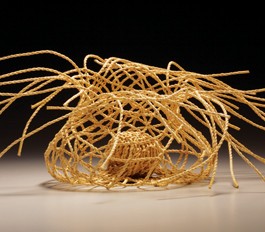Kate Eilertsen meets her visitor at the entrance and holds out a welcoming hand before turning on her heel and leading a tour of the Sonoma Valley Museum of Art’s new exhibit, “Life of Making.”
“This is a show,” she explains, “that I’ve been working on my whole life.”
Curating an exhibit—this is Eilertsen’s inaugural in her new role as SVMA’s executive director—does not literally take a lifetime, and the comment seems offhand, the exact sort of casual thing one might say to add pizzazz. But after Eilertsen has led the visitor through the airy museum, she sits down. Her father, she says, is a retired 84-year-old pastor living in Minnesota. Her voice takes a sad tone when she speaks of him. “He’s just given up,” she says. “He’s waiting to die. He’s the opposite of these people.”
“These people” are the exhibit’s stars, 91-year-old metal worker June Schwarcz, 79-year-old ceramicist Jim Melchert and 83-year-old fiber artist Kay Sekimachi, whose vibrant work well into the September of their years illuminates the idea of art as a catalyst for longevity. The exhibit examines whether, when human beings discover what they’re good at, passionate about and able to better master on a daily basis, they have a preternatural ability to live longer, healthier lives. “Life of Making” is laid out around this inspiration, and it’s something that Eilertsen clearly wishes her own father could possess.
While the show won’t be seen by Eilertsen’s dad, it flows from her sympathetic championing of perseverance. Schwarcz, the oldest of the three artists in the show, walks slowly every morning down to her studio to work with enamels from the Sausalito home she’s lived in since 1959; in the exhibit’s video installation, she quips, “I resent things that keep me from working.”
Some of Schwarcz’s early, architecture-inspired enamels are on display, with rigid lines on flat panels, but she eventually burst open the enamel-making process. Her newer pieces are beautiful bulbous vessels, loosely resembling cubic graduation caps, hatchet blades or sagging jeans. Small bubbles like tree sap frozen in time hang at the edges in very dynamic colors that shine ever more brilliant on the pieces’ interiors.
The Oakland-based Melchert is the best-known of the three artists—he served as visual arts programming director at the NEA, among other things—and his conceptual pieces are concerned with the natural imperfections in ceramics. Broken tiles are toyed with, their cracks becoming tree branches and their leftover ends, in the case of the square, bold, Density Squared, can be jumbled together in a busy, metropolitan relief map. Snapped electrical coils from Melchert’s kiln have burned the ceramic, creating work normally headed to the dumpster transformed and celebrated instead as centerpieces.
Sekimachi’s woven, hanging pieces may be the only overt reference to the winding down of life in the show. Casting long, lovely shadows on the museum floor, the ghostly, abstract hourglass figures wear flowing manes of telling white hair. Her earlier work, also, is on display, underscoring how age has opened Sekimachi up to fresh possibilities.
An adjoining room allows visitors the chance to interact with much of the same material used in the show, and Eilertsen speculates the exhibit will reach both the young and the old. Still, with work so vibrant coming from Schwarcz, Melchert and Sekimachi, the issue of age fades to the background in favor of passion and inspiration.
“I’m just curious about what keeps people healthy, and strong,” Eilertsen says. “This show could have been done with young people, too, and had the same idea. But having them as old as they are, it’s easier to understand that value.”
‘Life of Making’ runs through March 14, 2010, at the Sonoma Valley Museum of Art, 551 Broadway, Sonoma. Museum hours are Wednesday&–Sunday, 11am&–5pm. $5; Sundays, free. 707.939.7862.
Museums and gallery notes.
Reviews of new book releases.
Reviews and previews of new plays, operas and symphony performances.
Reviews and previews of new dance performances and events.











